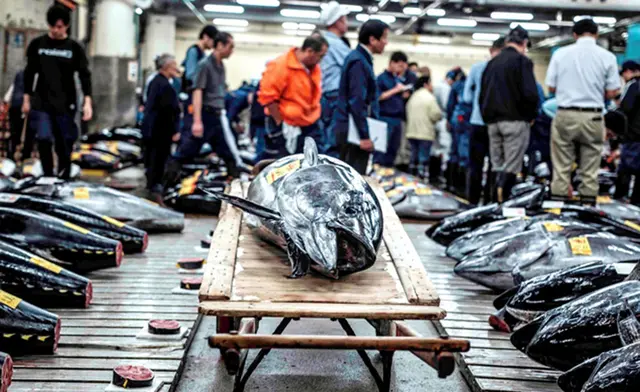A documentary due out next month provides a time capsule of Tokyo's Tsukiji market, known as "Japan's kitchen," which has played a key role in the development of the nation's world-acclaimed food culture.
“Tsukiji Wonderland” was shot at the market over 16 months. It records not only the attractive points of seafood and other foodstuffs, but also insights from the likes of intermediate wholesalers and sushi chefs to convey a culture unique to the market to future generations.
The Tsukiji market, located in the capital’s Chuo Ward, opened in 1935. Recently, many foreigners have visited the market mainly because “washoku” (Japanese cuisine) was registered as a UNESCO intangible cultural asset, and the market itself is promoted overseas as a symbol of Japan.
However, as it has aged, the market was scheduled to be relocated about two kilometers southeast to a site in the Toyosu district of Tokyo’s Koto Ward.
New Tokyo Governor Yuriko Koike has decided to postpone the planned relocation in November for environmental reasons, among others. For example, it has been found that soil replacement and land elevation to maintain the grounds’ safety have not been conducted beneath the market’s major buildings.
Still, the controversy apparently will not affect the release of "Tsukiji Wonderland," which will be screened at the Tsukiji Togeki theater near the market from Oct. 1 and at movie theaters throughout the country from Oct. 15.
About 600 hours of footage was shot for the documentary, which tells its story through the four seasons, the foodstuffs that come with them, and the dishes which use them.
For example, shellfish and icefish appear in the spring, and refreshing sweetfish and conger pikes come along with summer. Fish such as saury, barracuda and the largehead hairtail arrive in autumn, and fatty, rosy sea bass and pufferfish are winter delicacies.
Above all others, it is tuna that receives special treatment as the “king” of the market.
Intermediate wholesalers and sushi chefs sing the praises of the fish in the film.
“(Choosing) good domestic tuna is not a business act but a romantic one. Anyone can choose good tuna to some degree. But there is a world beyond that,” says one.
“When fishermen go to catch tuna, they risk their lives. Tuna has the biggest presence among all fish,” says another.
Scenes of an elementary school lunch were also shot for the film. An intermediate wholesaler visited the school as a volunteer to tell the children about fish, and as they listened and learned, each child tucked into a whole Japanese jack mackerel.
The children are shown flaking the fish with chopsticks awkwardly, their faces lighting up as they bring the flesh to their mouths.
The film’s producer, Maiko Teshima, 42, said that she thought seriously about how to make a “movie” using images that were like pieces of data.
“I wanted to depict the Tsukiji market from the aspect of it as a place to provide information about food culture,” she said.
Naotaro Endo, 38, the film's director, said: “This movie’s theme is ‘people.’ I want viewers to feel the passion of the people who work in the market, which is a limited space, and the battle of people who protect food safety at the same time while guarding the market’s traditions.”
“Tsukiji Wonderland” is narrated in English, as it is also expected to be screened overseas.
The movie also shows rare images from the time of the market’s opening in 1935. Those images were discovered when shooting of the film was under way, and Teshima and Endo were given permission to use them in the documentary.
(THE ASAHI SHIMBUN)
 简体中文
简体中文

